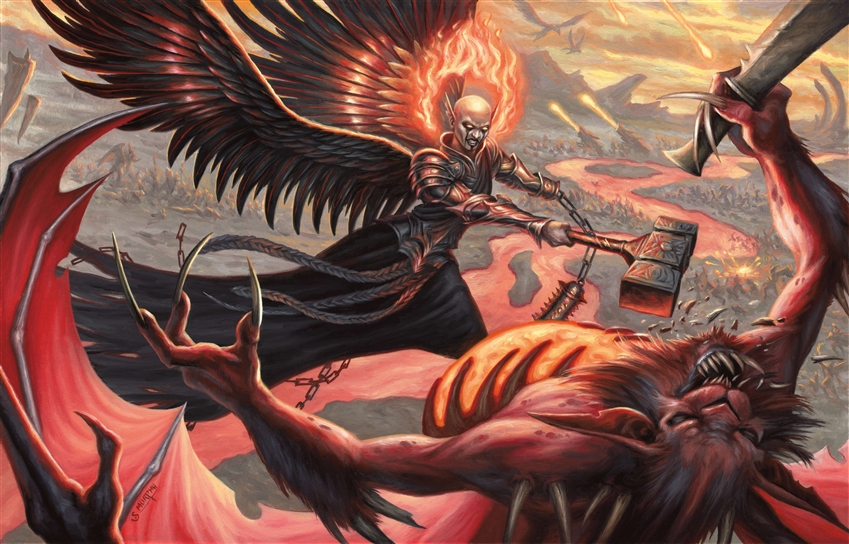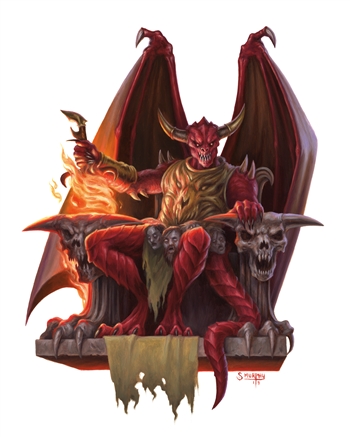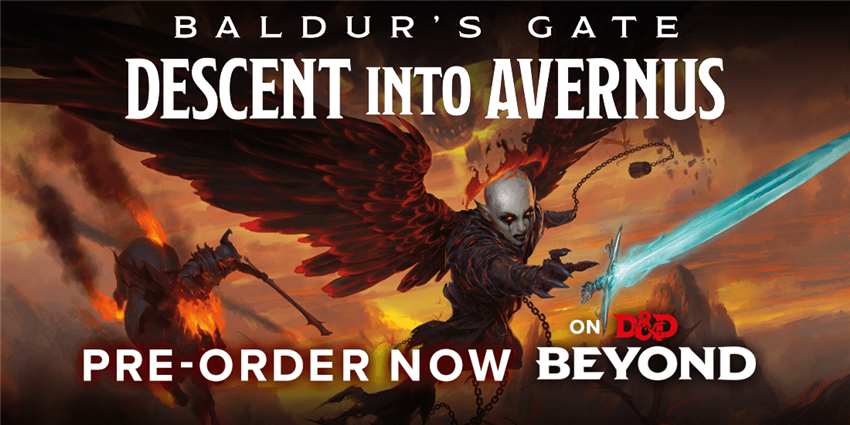Keep wasting my time with your pointless words and die, or join my war band and live. Choose swiftly. I have a plane to conquer.
Zariel is the central figure of Baldur's Gate: Descent into Avernus. Her pallid, flame-wreathed visage adorns the cover, and her bloodlust and zeal are central to the events of the story. She stands as a villain that could rival Strahd von Zarovich in depth and tragedy, and in significance. There's no doubt that we'll all learn more about Zariel, her past, and her importance to the next D&D storyline throughout the summer. For now, here's a primer on Zariel.
She Who Rules: A Canonical History of Zariel
Rule of Avernus has changed hands several times over the eons. Three major players have vied for control over Avernus in recent days, and the politics of the Nine Hells are bloodier than any mortal war. A pit fiend known as Bel was once the ruler of Avernus. His mastery of battle tactics was legendary, and he was a great bulwark against the Hells’ enemies, namely the demons of the Abyss. The dragon goddess Tiamat is also a resident of Avernus, though her existence there has constantly confounded mortal scholars. Is Tiamat a part of Avernus’s political landscape, or is she a prisoner there? As we learned in the Tyranny of Dragons storyline, Tiamat can’t leave the Nine Hells of her own free will; only her worshipers can call her from the Lower Planes.
Most notable of these rulers, however, is the archduchess Zariel, a former celestial who willingly joined Asmodeus’s infernal cadre. Once, long ago, Zariel served the heavenly host of Mount Celestia, and played her part in the celestials’ eternal war against evil. So great was her zeal, however, that she rankled at the measured caution and restraint of her superiors.

Zariel’s past plays a key role in the story of Baldur’s Gate: Descent into Avernus, so we can’t spoil too much. Suffice to say, Zariel defied her superiors’ orders one fateful day, and called a band of her most loyal warriors to break a demonic invasion on the Material Plane. Zariel’s zealotry ultimately drove her to defeat, but she was visited in her most desperate hour by an unlikely ally: Asmodeus himself. The Zariel had once tried to testify before Primus, master of the Modrons and avatar of absolute order, at Asmodeus’s trial in ages past, but now the Lord of the Nine Hells was poised to save Zariel’s life, and to offer her a deal she couldn’t refuse: to battle demons on her own terms, forever. The cost was simple: join Asmodeus as an archdevil and rule Avernus.
Zariel accepted.
Asmodeus smote Bel and stripped him of the title of archduke and all the supernatural powers it bestowed, and installed Zariel as ruler of Avernus. Nevertheless, Asmodeus recognized Bel’s military prowess and, in a quirk of cruelty, appointed him as Zariel’s chief lieutenant. The disgruntled Bel serves his new archduchess in the name of defending the Nine Hells, but he and his loyal allies scheme to supplant her and regain his favor with the great Asmodeus.
My legions are the only thing standing between your precious Seven Heavens and the bottomless hunger of the Abyss. I did not fall into the clutches of evil. I rose to shoulder a cosmic burden.
— Zariel, Archduchess of Avernus, former angel of Celestia;
She Who was Imprisoned: A Historiography of Zariel
Zariel first appeared in D&D canon in A Guide to Hell (1999), a late AD&D 2nd edition book written by Chris Pramas and published by Wizards of the Coast, shortly after they acquired Dungeons & Dragons from the bankrupt TSR. While information from sourcebooks of earlier editions of D&D aren't non-canon per se, books from the current edition (like Mordenkainen's Tome of Foes) should be considered authoritative. This historiography examines how Zariel was used by developers of editions past, how her motivations and origins have changed or stayed the same, and could even give you some alternate ideas about how to play this most notable of fallen angels.
The Blood War was central to the lore of the Nine Hells and the Abyss, thanks to the influence of Planescape, one of the hallmark campaign settings of 2nd edition AD&D. In this book, Zariel is a central figure in an event known as the Reckoning of Hell, a rebellion in which all eight archdevils who serve Asmodeus betrayed their master. Zariel began the rebellion and the Reckoning saw its birth in Avernus. This rebellion was ultimately unsuccessful, as the archdevil Geryon betrayed the rebels and chose to side with Asmodeus. In the end, Asmodeus proved the victor—yet the Lord of the Nine Hells was capricious and magnanimous in victory. For reasons unknown, he allowed all seven of the renegade archdevils to retain their stations, while Geryon, the only one who had remained loyal to him, was cast down from his position of power.

This book situates Bel as Lord of Avernus, despite Asmodeus graciously allowing Zariel to retain her position. Bel was Zariel's loyal lieutenant, yet sometime after the Reckoning, Bel overthrew and imprisoned Zariel, and Asmodeus sent a messenger congratulating him on his coup. He siphoned power from Zariel for untold ages, but never gained favor with the Nine Hells' other archdevils. All saw him as "Bel the Pretender," and Asmodeus was pleased to replace the troublesome and scheming Zariel with a mere pit fiend who was too busy serving as a general in the Blood War to meddle in political affairs.
Ultimately, the Zariel presented in A Guide to Hell is much more conniving and scheming than the warmongering and politically averse Zariel we've been exposed to in Mordenkainen's Tome of Foes and at The Descent.
Zariel had a few brief mentions throughout the life of 3rd edition D&D in the Manual of the Planes (2001) and Fiendish Codex II: Tyrants of the Nine Hells (2006), but even in these books, Zariel remained Bel's prisoner, and the beleaguered pit fiend remained master of Avernus. Now in fifth edition D&D, Zariel is back. It's unclear how exactly she was freed from Bel's clutches and regained her control over Avernus—or if this element of her story is still canon at all! It's possible that Zariel's imprisonment has been retconned out of existence, and now Bel's relationship to Zariel is merely one of a deposed archdevil allowed to remain her lieutenant.
Zariel's imprisonment could, however, be viewed as a way to explain her shift in personality between earlier editions and fifth edition. Before, she was just as political and devious as the other archdevils. These days, she's sworn to battle, and has little time for schemes. Being imprisoned and devoured daily by a former lieutenant changes a person, even an archdevil. Zariel may no longer trust anyone, leading her to strive to be self-sufficient, and try to shoulder the burden of the entire Blood War herself.

What do you think of Zariel? Are you excited for Baldur's Gate: Descent into Avernus? It's available for pre-order now on the D&D Beyond Marketplace!
 James Haeck is the lead writer for D&D Beyond, the co-author of Waterdeep: Dragon Heist and the Critical Role Tal'Dorei Campaign Setting, the DM of Worlds Apart, and a freelance writer for Wizards of the Coast, the D&D Adventurers League, and Kobold Press. He lives in Seattle, Washington with his partner Hannah and their hellcats Mei and Marzipan. You can find him wasting time on Twitter at @jamesjhaeck.
James Haeck is the lead writer for D&D Beyond, the co-author of Waterdeep: Dragon Heist and the Critical Role Tal'Dorei Campaign Setting, the DM of Worlds Apart, and a freelance writer for Wizards of the Coast, the D&D Adventurers League, and Kobold Press. He lives in Seattle, Washington with his partner Hannah and their hellcats Mei and Marzipan. You can find him wasting time on Twitter at @jamesjhaeck.








-
View User Profile
-
Send Message
Posted May 19, 2019Can’t wait to run this for my own group. They love smiting fiends as a group of all paladins. They loved Out of the Abyss and couldn’t wait for another fiend based module.
-
View User Profile
-
Send Message
Posted May 19, 2019Im more interested in how this book can be adapted to non-FR settings like Planescape and Eberron, though I love the idea of a redeemable arch-villain.
-
View User Profile
-
Send Message
Posted May 19, 2019One of the things I really like about devils is that they are so different. With demons, they are mostly the same; rawr, rawr, destroy. Take over world. Turn everyone into a slave or kill everyone. But with devils, there are scheming ones (like Dispater), but there are also ones that are more CE, like Zariel or Bael.
-
View User Profile
-
Send Message
Posted May 19, 2019Eberron may be a challenge because its planes are different, but Planescape is a perfect fit! Starting the story in Sigil rather than Baldur's Gate should be no problem.
-
View User Profile
-
Send Message
Posted May 19, 2019I think I prefer her design in Mordenkainen's Tome. Something about the sharp ears, flaming halo and... mascara is a bit too over the top for me. And yes, I know her design in Mordenkainen's has flaming wings and horns. Shut up.
-
View User Profile
-
Send Message
Posted May 19, 2019I still remember a time when Devil and Demon were call Baatezu and Tanar'ri. I still call them that today. For some reason, I confuse Devil and Demon
-
View User Profile
-
Send Message
Posted May 19, 2019I think the new one is vastly superior....to each their own I guess. I thought she looked like a demon with eczema in Mordenkainen's.
-
View User Profile
-
Send Message
Posted May 20, 2019Anyone else notice how Zariel has a flail for a left hand all of a sudden?
-
View User Profile
-
Send Message
Posted May 20, 2019In Baldur's Gate: Descent int Avernus, can players overthrow Zariel and become the new leaders of Avernus? Would Asmodeus approve? Would the players actually become devils?
-
View User Profile
-
Send Message
Posted May 20, 2019Yeah. In all the Images, she has a flail for a left hand. What's up with that? Do you think she lost the hand somehow. It's probably story related...
-
View User Profile
-
Send Message
Posted May 20, 2019I'm kind of curious about that sword. She's using a warhammer in one picture there.
-
View User Profile
-
Send Message
Posted May 20, 2019I remember when I played my Epic Blighter and along with my squad, including Antilia, Mephistopheles' half-devil bard daughter, decided that the Nine Hells Hierarchy could benefit from more of a feminine touch. With the backing of Glasya, Fierna, and a True Resurrected Benzosia, we freed Zariel from the torture chambers of Bel and reestablished her as Archduchess of Avernus. I was happy to see that canonical D&D eventually followed our quest. Oh and Asmodeus lent tacit approval too. Good times.
-
View User Profile
-
Send Message
Posted May 20, 2019God this is so metal. As soon as I read about Zariel she was an instant hit for me. I made a worshipper of her as well as my own Zariel-centric adventure in hell that was a blast. I cant wait to return and do a whole full campaign with her in it. Though Strahd had my heart for so long, she's vying to become my new favorite villain to use.
-
View User Profile
-
Send Message
Posted May 21, 2019Maybe they make her more cunning like hobgoblins.
-
View User Profile
-
Send Message
Posted May 21, 2019"shortly after they acquired Dungeons & Dragons from the bankrupt TSR. " Wow, that is a harsh sentence.
-
View User Profile
-
Send Message
Posted May 21, 2019Perhaps a dumb question, but I’m curious.
In the promo image of The Descent event, Zariel appears as a celestial, but she is blindfolded. Does that mean that she was blind? In fact, is she blind as a fiend?
Thanks!
-
View User Profile
-
Send Message
Posted May 21, 2019Well, they say the truth hurts, and it's exactly what happened, so...
-
View User Profile
-
Send Message
Posted May 22, 2019I feel like this sentence is missing a phrase (e.g. "is unclear").
-
View User Profile
-
Send Message
Posted May 26, 2019Almost all of the interviews have said that Zariel can be redeemed but that leads me to wonder how it will affect all the Zariel-descended Tieflings out there. Are they turned into Aasimar or does her influence not extend to her Tieflings or is she redeemed on a soul level but not physically? Can't wait to see the mass conversion of Tieflings out there.
-
View User Profile
-
Send Message
Posted May 27, 2019I think it's a metaphor for her mission. Blind retribution against fiends. She saw a conflict of 2 different evils and truly believed she could wipe out both so sight wasn't an issue. If you wade into a crowd of people, swinging a sword, you have a 100 percent chance of hitting something. So she was in a Blind Rage.